Vintage camp stove collecting information

Vintage camp stove collecting can be a fun and rewarding hobby for outdoor enthusiasts, historians, and collectors. Collecting vintage camp stoves allows you to appreciate the history and evolution of camping technology, as well as the craftsmanship and design of these classic items.
Camp stove history
When talking about camp stoves, camp point towards the broadest form of use. These vintage stoves were used outdoors, on the camping, while hiking, during a boat trip or on a motorcycle trip. But when going back a little further in time like the 1900’s and even earlier, these stoves were also used in the kitchen or home. The manufacturers of these home stoves were looking for ways to sell more stoves so they made them smaller and even collapsible. These stoves are fueled by various types of fuel such as propane, butane, white gas, or kerosene.

Many countries had their own manufacturers but often these stoves are modelled after the Swedish birth ground models. Creating the discus type brass stove which is a clear “form follows function” design. This shape is shown above in different stoves that look the same from a first glance and one in close up below…a rare Radius 17R classic brass camp stove. But read on…it gets better!
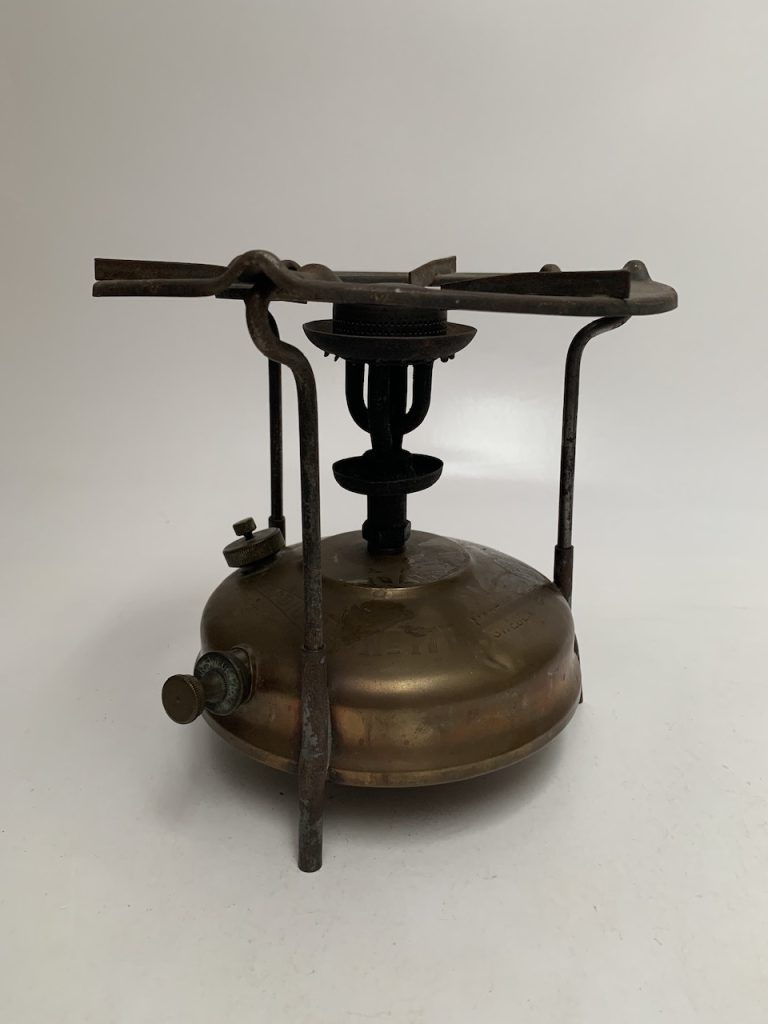
A pretty cool addition to the classic camp stove was the heater attachment, which immediately shows the potential of the stove to be used in many more ways. Even a lantern could be fitted but most manufacturers set of to create complete lanterns as sellable item rather than selling just one tank with many accessories. Below are to heaters on the left the model 110 by Primus and on the right the model 33 by Radius.
Popular camp stove brands
The Primus name in many countries is synonymous for a classic camp stove. This is not only a name often used to indicated a classic stove but it is also a Manufacturer from Sweden. Sweden is a large open country that is great for hiking, camping and other outdoor activities. The weather ranges from very cold in the North to a nice graduate climate in the south. This is probably why there were many manufacturers of camp stoves. From Sweden there are several known brands which are Primus, Sievert/Svea Radius and Optimus. The companies were combined from the 1960’s onwards under the Optimus brand name and still for one company today, producing various of the classic models still.




In other countries there were also many mankers. From Germany there were also many brands like Gustav Barthel, Petromax, Enders, Bat, ANHO, Standard and AIDA.




From other countries we have Phoebus from Austria, from Portugal Hipolito and Meva from Czechoslovakia, from Russia I once found a Pekopa and from Hungary a Perpetum (see if you can make out the names on the tanks).




Many countries have their own brands and as I encounter them I will add pictures and names in this article. I found a Liberty from India and a Butterfly from Malaysia. In addition I found a Salsius from France and Ökzur from Turkey. After some digging into this brand I could not find much but I did discover other brands from Turkey like Yûksel, DEVE and Süreyya.




Then we have the Coleman brand which is from the USA originally but also had models made in Canada and even in England. The one below is a Solus from Canada. Also from England is the Burmos brand.

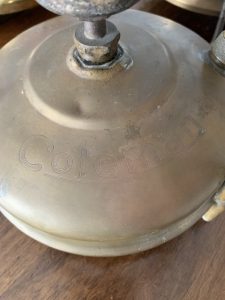
This list is not complete at all because there seem to have been many small brands. I will keep adding more as I run into them. If you need to find a certain brand, do make sure to check the great list, called fittingly “the stove reference gallery” at classiccampstoves.com.
Vintage camp stoves in all forms and sizes
While the classic discus stove is a field of collecting by itself, specially when you are zooming in on the development of the individual stove over the decades, there are many more things to consider…collecting wise. First let’s consider the build. First picture shows the Phoebus 625 in real life and below that the explaining pictures, that shows the individual parts.
Tank below and burner on top of that with 3 pot stands to be fitted into the tank. This the basic design of many stoves, based on the discus stove. And why change this design? Well some manufactures like Phoebus made small improvements in order to fit it in a can (the pot stands swivel and need not to be taken out). It also has an adjuster knob on the side that can be taken down (which is something that was also found on later discus stoves by the way). But other brands took it a bit further, Below you find the classic Optimus 8/8R configuration. With the tank in front and the burner behind it, this makes a very compact stove. The German Touring Turn is the one in the 2 pictures on the right. It is a fully collapsable flat folding stove with the tank on top and making use of gravity to feed the burner rather than using a pump.
Other compact stoves that come to mind are the Radius 43, the Svea 123, Meva 2140 (right) and the Primus 71 (left). All have a similar design, build straight up to be narrow and light for backpacking / hiking. The Svea (middle) even includes a small pan.
Then there were specific stoves made for the Army. Various countries had different models of stoves for their troops. Depending on their special needs, the contracts and the political era there are many brands and models. Sometimes there are Army issue and standard issues for the normal public. The stoves for the military were even easier to service in the field and painted in specific color for the armies needs. Below an Enders 9061 from 1966 made for the German Bundeswehr (Army).
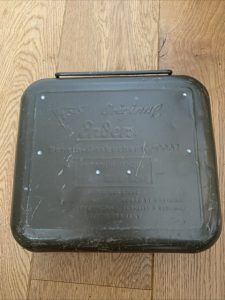


Some thoughts on starting a collection
To start your collection, you can search for vintage camp stoves in antique stores, online marketplaces, or at outdoor flea markets and swap meets. It’s important to educate yourself on the different types and brands of vintage camp stoves, as well as their condition and rarity. In addition to collecting vintage camp stoves, you can also join online forums and communities to connect with other collectors and enthusiasts. You can share your knowledge and expertise, as well as learn from others about the history and value of vintage camp stoves. The best website on vintage camp stoves would be www.cassiccampstoves.com which has great reference material and beautiful galleries!
Overall, vintage camp stove collecting can be a fun and rewarding hobby that allows you to appreciate the history and craftsmanship of camping equipment, while also connecting with other enthusiasts. Of course you decide what can be your collecting focus. I personally like a full set as shown above. This Petromax comes with the original case and even the outer box, tools and paperwork. Only a part of the stove sold came in original tin boxes but these often get heavy signs use but are great if they survived (some shown below)!

Fettling, polishing and general maintenance
In most areas of collecting there are different groups of collectors with different views towards use. Specially in collecting vintage there is the question of functionality or “Does it work”. In most cases one just want to know if all parts are there and if needed could if be used. One collector loves a barn find and will leave it as found, enjoying the patina and showing the life it had as well as all it’s adventures dents it collected. The other end of the scope would be a never used “NOS” or New Old Stock example that is still in the box and really never fired up (but these are rather rare ), see the Phoebus 625 above and the Svea below both from the 1980’s or so. And probably these NOS models will not work right away because of seals and pump gaskets that got hard. In reality a stove will be somewhere in between, used and loved and ready for action.

Most and almost all stoves will need some fettling (the art of resurrecting a dead stove) sooner or later..up to the point it is usable again. And in theory all stoves can be fettle back to life. Some stoves may have big issues and be beyond easy repair but most stoves will work with a little maintenance and TLC (Tender Love and Care), replacing the gaskets and reviving the pump leather. Not matter if it was NOS or found in a barn. See below for a big restauration movie I found on YouTube:
Besides restoration there is the issue of simple maintenance. When you want to use your stove during a hiking trip or on your camp site. The least you want to have is the correct size pricker, the correct fluids for lighting and burning your stove as well a spanner for taking it apart. Keep in mind that these vintage stoves were made to be used a lifetime and needed to be cleaned and operated in the field. Still it might be smart to bring a backup stove but still you should be able to easily fix most common issues with a little cleaning, a pricker and some common sense. If you are not up to this task, please steer clear of this area of collecting. Yes I have had buyer complaining a perfectly working stove did not work because they did not have the common sense and/or patience to fire it up correctly.
And then there is the polishing issue. You like it or you do not. Your choice. Just a word of advise. Be careful and do not over polish. Start with a soft cloth and some soapy water before grabbing the expert brass polish and heavy grinding materials. Brass is a soft metal and a stove gets heavily polished the beautiful markings may fade or you could leave scratch marks.



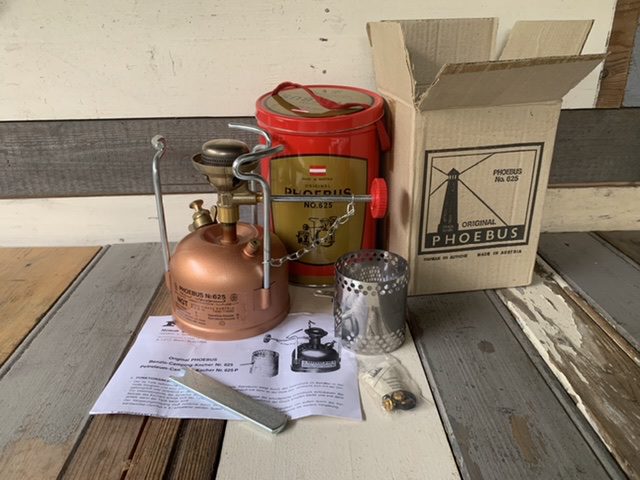
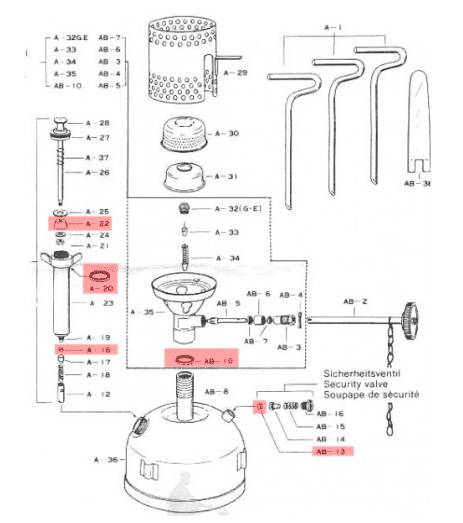

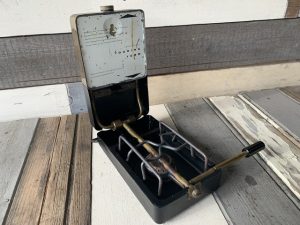





selamat pagi, perkenalkan saya Aris dari Semarang saya memiliki kompor kamping merk Aida Germany, ada tulisa Aida No. 1
saya cari di google kok tida ketemu adanya no.100 apakah punya saya termasuk vintage?
Hi Aris,
All Aida stoves are vintage. On this website you find the Aida 100 and 220. There also is a 1 featured on the classiccampstoves website! Warm regards Kevin from VintageManStuff